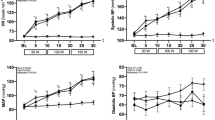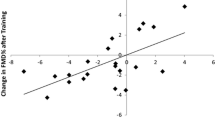Abstract
Purpose
Previous studies that have examined the impact of exercise intensity on conduit artery endothelial function have involved large muscle group exercise which induces local and systemic effects. The aim of this study was to examine flow-mediated dilation (FMD) before and after incremental intensities of handgrip exercise (HE), to assess the role of local factors such as blood flow and shear rate on post-exercise brachial artery function.
Methods
Eleven healthy men attended the laboratory on three occasions. Subjects undertook 30 min of handgrip exercise at three intensities (5, 10 or 15 % MVC). Brachial artery FMD, shear and blood flow patterns were examined before, immediately after and 60 min post exercise.
Results
Handgrip exercise increased mean and antegrade shear rate (SR) and blood flow (BF) and reduced retrograde SR and BF (all P < 0.01). Exercise intensity was associated with a dose-dependent increase in both mean and antegrade BF and SR (interaction, P < 0.01). Post-hoc tests revealed that, whilst handgrip exercise did not immediately induce post-exercise changes, FMD was significantly higher 60 min post-exercise following the highest exercise intensity (5.9 ± 2.8–10.4 ± 5.8 %, P = 0.01).
Conclusions
Handgrip exercise leads to intensity-and time-dependent changes in conduit artery function, possibly mediated by local increases in shear, with improvement in function evident at 1 h post-exercise when performed at a higher intensity.



Similar content being viewed by others
Abbreviations
- ANOVA:
-
Analysis of variance
- BF:
-
Blood flow
- DBP:
-
Diastolic blood pressure
- FMD:
-
Flow-mediated dilation
- HE:
-
Handgrip exercise
- LMM:
-
Linear mixed model
- LSD:
-
Least significant difference
- MAP:
-
Mean arterial pressure
- MVC:
-
Maximal voluntary contractile
- ROS:
-
Reactive oxygen species
- SBP:
-
Systolic blood pressure
- SR:
-
Shear rate
References
Atkinson G, Batterham AM, Thijssen DH, Green DJ (2013) A new approach to improve the specificity of flow-mediated dilation for indicating endothelial function in cardiovascular research. J Hypertens 31:287–291
Birk GK, Dawson EA, Batterham AM, Atkinson G, Cable T, Thijssen DH, Green DJ (2013) Effects of exercise intensity on flow mediated dilation in healthy humans. Int J Sports Med 34:409–414
Chappell DC, Varner SE, Nerem RM, Medford RM, Alexander RW (1998) Oscillatory shear stress stimulates adhesion molecule expression in cultured human endothelium. Circ Res 82:532–539
Corretti MC et al (2002) Guidelines for the ultrasound assessment of flow-mediated vasodilation of the brachial artery. J Am Coll Cardiol 39:257–265
Dawson EA et al (2008) Changes in vascular and cardiac function after prolonged strenuous exercise in humans. J Appl Physiol 105:1562–1568
Dawson EA, Green DJ, Cable NT, Thijssen DH (2013) Effects of acute exercise on flow mediated dilatation (FMD) in healthy humans. J Appl Physiol 115:1589–1598
Gocke N, Keaney JF, Hunter LM, Watkins MT, Nedelijkovic ZS, Menzoian JO, Vita JA (2003) Predictive value of non-invasively determined endothelial dysfunction for long-term cardiovascular events in patients with peripheral vascular disease J. Am J Cardiol 41:1769–1775
Goel R et al (2007) Exercise-induced hypertension, endothelial dysfunction, and coronary artery disease in a marathon runner. Am J Cardiol 99:743–744
Gonzales JU, Thompson BC, Thistlethwaite JR, Scheuermann BW (2011) Association between exercise hemodynamics and changes in local vascular function following acute exercise. Appl Physiol Nutr Metabol Physiologie appliquee nutrition et metabolisme 36:137–144. doi:10.1139/H10-097
Goto C et al (2003) Effect of different intensities of exercise on endothelium-dependent vasodilation in humans. Role of endothelium-dependent nitric oxide and oxidative stress. Circulation 108:530–535
Green DJ (2009) Exercise training as vascular medicine: direct impacts on the vasculature in humans. Exerc Sport Sci Rev 37:196–202
Green DJ, Cheetham C, Reed C, Dembo L, O’Driscoll G (2002) Assessment of brachial artery blood flow across the cardiac cycle: retrograde flows during lower limb exercise. J Appl Physiol 93:361–368
Green DJ, Bilsborough W, Naylor LH, Reed C, Wright J, O’Driscoll G, Walsh JH (2005) Comparison of forearm blood flow responses to incremental handgrip and cycle ergometer exercise: relative contribution of nitric oxide. J Physiol 562:617–628
Green DJ, O’Driscoll G, Joyner MJ, Cable NT (2008) Exercise and cardiovascular risk reduction: time to update the rationale for exercise? J Appl Physiol 105:766–768
Green DJ, Dawson EA, Groenewoud HM, Jones H, Thijssen DH (2014) Is flow-mediated dilation nitric oxide mediated?: a meta-analysis. Hypertension 63:376–382
Hambrecht R et al (2003) Regular physical activity improves endothelial function in patients with coronary artery disease by increasing phosphorylation of endothelial nitric oxide synthase. Circulation 107:3152–3158
Harvey PJ, Picton PE, Su WS, Morris BL, Notarius CF, Floras JS (2005) Exercise as an alternative to oral estrogen for amelioration of endothelial dysfunction in postmenopausal women. Am Heart J 149:291–297
Himburg HA, Dowd SE, Friedman MH (2007) Frequency-dependent response of the vascular endothelium to pulsatile shear stress. Am J Physiol Heart Circ Physiol 293:645–653
Hwang J et al (2003) Pulsatile versus oscillatory shear stress regulates NADPH oxidase subunit expression: implication for native LDL oxidation. Circ Res 93:1225–1232
Johnson BD, Padilla J, Wallace JP (2012) The exercise dose affects oxidative stress and brachial artery flow-mediated dilation in trained men. Eur J Appl Physiol 112:33–42
Jones H, Green DJ, George K, Atkinson G (2010) Intermittent exercise abolishes the diurnal variation in endothelial-dependent flow-mediated dilation in humans. Am J Physiol Regul Intergr Comp Physiol 298:427–432
Joyner MJ, Green DJ (2009) Exercise protects the cardiovascular system: effects beyond traditional risk factors. J Physiol 587:5551–5558
Laughlin MH, McAllister RM (1992) Exercise training-induced coronary vascular adaptation. J Appl Physiol 73:2209–2225
Laughlin MH, Newcomer SC, Bender SB (2008) Importance of hemodynamic forces as signals for exercise-induced changes in endothelial cell phenotype. J Appl Physiol 104:588–600
Llewellyn TL, Chaffin ME, Berg KE, Meendering JR (2012) The relationship between shear rate and flow-mediated dilation is altered by acute exercise. Acta Physiol 205:394–402
Padilla J, Harris R, Fly A, Rink L, Wallace J (2006) The effect of acute exercise on endothelial function following a high-fat meal. Eur J Appl Physiol 98:256–262
Padilla J, Harris RA, Wallace JP (2007) Can the measurement of brachial artery flow-mediated dilation be applied to the acute exercise model? Cardiovasc Ultrasound 5:45
Padilla J, Simmons GH, Vianna LC, Davis MJ, Laughlin MH, Fadel PJ (2011) Brachial artery vasodilatation during prolonged lower limb exercise: role of shear rate. Exp Physiol 96:1019–1027
Rognmo O et al (2008) Endothelial function in highly endurance-trained men: effects of acute exercise. J Strength Cond Res 22:535–542
Schreuder TH, Green DJ, Hopman MT, Thijssen DH (2014) Acute impact of retrograde shear rate on brachial and superficial femoral artery flow-mediated dilation in humans. Physiol Rep 2:e00193
Takase B et al (1998) Endothelium-dependent flow-mediated vasodilation in coronary and brachial arteries in suspected coronary artery disease. Am J Cardiol 82:1535–1539
Thijssen DHJ et al (2008) The impact of baseline diameter on flow mediated dilation (FMD) differs in young and older humans. Am J Physiol Heart Circ Physiol 295:1594–1598
Thijssen DHJ et al (2009a) Does arterial shear explain the magnitude of flow-mediated dilation?: a comparison between young and older humans. Am J Physiol Heart Circ Physiol 296:57–64
Thijssen DHJ, Dawson EA, Black MA, Hopman MTE, Cable NT, Green DJ (2009b) Brachial artery blood flow responses to different modalities of lower limb exercise. Med Sci Sports Exerc 41:1072–1079
Thijssen DHJ, Dawson EA, Tinken TM, Cable NT, Green DJ (2009c) Retrograde flow and shear rate acutely impair endothelial function in humans. Hypertension 53:986–992
Thijssen DHJ et al (2011) Assessment of flow mediated dilation (FMD) in humans: a methodological and physiological guideline. Am J Physiol Heart Circ Physiol 300:2–12
Tinken TM et al (2009) Impact of shear rate modulation on vascular function in humans. Hypertension 54:278–285
Tyldum GA, Schjerve IE, Tjonna AE, Kirkeby-Garstad I, Stolen TO, Richardson RS, Wisloff U (2009) Endothelial dysfunction induced by post-prandial lipemia: complete protection afforded by high-intensity aerobic interval exercise. J Am Coll Cardiol 53:200–206
Williams MRI, Westerman RA, Kingwell BA, Paige J, Blombery PA, Sudhir K, Komesaroff PA (2001) Variations in endothelial function and arterial compliance during the menstrual cycle. J Clin Endocrinol Metab 86:5389–5395
Woodman RJ et al (2001) Improved analysis of brachial artery ultrasound using a novel edge-detection software system. J Appl Physiol 91:929–937
Zhu W, Zeng J, Yin J, Zhang F, Wu H, Yan S, Wang S (2010) Both flow-mediated vasodilation procedures and acute exercise improve endothelial function in obese young men. Eur J Appl Physiol 108:727–732
Acknowledgments
We would like to thank the participants for their time in completing this research study. Professor Green’s research is supported by the National Health and Medical Research Council (NHMRC) Grant ID 1045204.
Conflict of interest
The authors declare that they have no conflict of interest.
Ethical standard
All procedures performed in studies involving human participants were in accordance with the ethical standards of the institutional and/or national research committee and with the 1964 Helsinki declaration and its later amendments or comparable ethical standards. Informed consent was obtained from all individual participants included in the study.
Author information
Authors and Affiliations
Corresponding author
Additional information
Communicated by Massimo Pagani.
Rights and permissions
About this article
Cite this article
Atkinson, C.L., Carter, H.H., Dawson, E.A. et al. Impact of handgrip exercise intensity on brachial artery flow-mediated dilation. Eur J Appl Physiol 115, 1705–1713 (2015). https://doi.org/10.1007/s00421-015-3157-1
Received:
Accepted:
Published:
Issue Date:
DOI: https://doi.org/10.1007/s00421-015-3157-1




